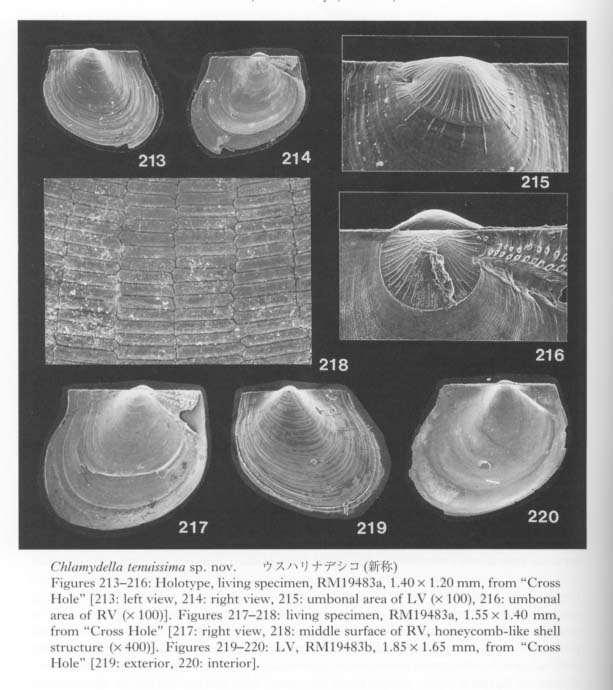Chlamydella tenuissima sp. nov.
Figures 213-220

1992. Chlamydella sp., Kase and Hayami,Jour. Moll. Studies, vol.58, p.448, listed.
Type and material.—Holotype: RM19483a, a living specimen from the bottom sediments of "Cross Hole" of Irabu Islet, Miyako Islands. Paratypes: RM19475 (living) from "Devil's Palace", RM19476 (living) from "Fool's Palace", RM19477 (dead) from "Witch's House", RM19603 (living) from "Wall Cave", RM19478 (living) from "Toriike", RM19479 (living) from "Black Hole", RM19602 (living) from "Coral Hole" of Shimoji Islet. RM19480 (dead) from "Lunch Hole", RM19481 (living) from "W-arch", RM19482 (dead) from "L-arch", RM19483 (living) from the type locality of Irabu Islet. RM19484 (dead) from "Shodokutsu" of Ie Islet.
Diagnosis.—Small-sized brooding species of Chlamydella, characterized by very thin, hyaline and prosoclinal shell, granular ornaments on byssal auricle, nearly smooth surface of LV except for a few sparse divergent striae, and large low-conical Pd I which is radially striated and possesses rudimentary byssal notch in each valve.
Description.—Shell very small, scarcely exceeding 2.2 mm in length, highly inequivalve, prosocline, hyaline, translucent, extremely thin, longer than high. Auricles (except for byssal one) not clearly delimited from disk. LV more strongly convex than RV. Dorsal margin long, occupying almost whole length of shell. Byssal auricle relatively short, supported by a wide byssal fasciole. Disk and auricles of LV nearly smooth, but commonly with several sparse divergent striae which are irregular in prominence and intervals but always perpendicularly cross growth lines. Disk and posterior auricle of RV apparently smooth, and microscopically revealing commarginally elongated honeycomb-like hexagonal calcitic prisms of outer layer. Surface of byssal auricle exhibits three (or four) radial rows of tubercles which occur at intersections with commarginal lamellae. Resilium pit low-triangular, located near mid-point of dorsal margin. Pd I very large, ranging 261-298 µm in maximum diameter, low-conical, characterized by rudimentary byssal notch in each valve as well as pitted proximal part and radially striated distal part; Pd II absent.
Remarks.—The present species is found attached by byssus to the sediment particles, polychaete tubes and wall surface in many caves. It is also a brooding species; many specimens collected in late June of 1992 and middle April of 1993 bear several embryos which seem to attach themselves to parent ctenidia.
It is somewhat similar to Cyclopecten favus Hedley, 1902, the type species of Chlamydella, from the lower neritic substrata of New South Wales. The radially disposed honeycomb-like prismatic microstructure of the external surface of RV agrees well with that of the Australian species. If compared with the holotype of C. favus, however, the present specimens show somewhat smaller shell, longer dorsal margin and stronger sculpture of byssal auricle. Moreover, divergent striae on LV are not seen, and the Pd I is much smaller and not radially striate in Hedley's specimen.
The relation between the present species and Chlamydella incubata sp. nov. is another problem. The two species often occur sympatrically in many submarine caves of the Ryukyu Islands, though the relative frequency is significantly different among localities. They share nearly the same microhabitats, poorly denned auricles, wide marginal apron and commarginally elongate honeycomb-like prismatic microstructure of RV. The present species, however, is distinguishable from C. incubata by the 1) more translucent, hyaline and prosoclinal shell, 2) undeveloped cancellate sculpture in LV, 3) somewhat shorter byssal auricle, 4) less salient Pd I with radially (not diagonally) striate surface and finely pitted central part, and 5) more commarginally elongated simple prisms in RV. Although the outline and surface sculpture show wide ranges of intrapopulational variation, there is a clear morphological gap between the two species.
Distribution.—Locally abundant in some sublittoral caves of Shimoji, Irabu and Ie Islets, Ryukyu Islands.